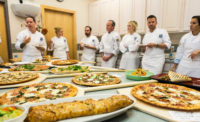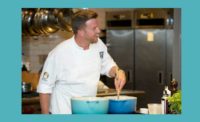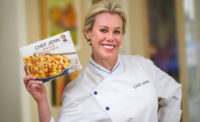Collective Wisdom from the Chef Community
The Schwan Food Company’s new “Chef Collective” program brings outside culinary talent, perspectives to the new product development process


























The Schwan Food Company, Marshall, Minn., greeted the New Year with a new initiative to spur a new wave of culinary inspiration and innovation across the company’s many product categories and distribution channels.
As a part of a newly formed “Schwan’s Chef Collective,” chefs will partner with the Schwan culinary team based in Marshall, Minn. The inaugural 10-person team includes seven accomplished chefs (external to the company) who have honed their crafts in diverse culinary ventures across the country — from restaurants to food trucks and even the development of cookbooks. Schwan’s says each member of the team “brings a unique perspective and is tasked with scouting emerging ingredients, cooking methods and global cuisines to continually influence the innovation of Schwan foods.”
The announcement followed Schwan’s simplicity ingredient initiative, a commitment to removing four ingredient groups from foods sold by every subsidiary of Schwan, including Schwan’s Home Service, Inc., Schwan’s Consumer Brands, Inc. and Schwan’s Food Service, Inc.
“We believe the Schwan’s Chef Collective will help us change the way people think about the frozen-food category," said Dimitrios Smyrnios, CEO of The Schwan Food Company. "We are proud to work with these talented chefs to make a spectrum of great food—indulgent-to-wholesome, convenient-to-authentic and simple-to-sophisticated—with the goal of exciting our retail, food-service and home-delivery customers."
Stacey Fowler is senior vice president of product innovation and development at The Schwan Food Company.
“Our team is constantly eating, tasting and sampling, and we gain insights from other leaders in the food world,” she says. “Schwan’s Chef Collective enables us to dive deeper into emerging trends and consumers' ever changing lifestyles to develop new, delicious and wholesome recipes with quality ingredients.”
Schwan’s Chef Collective member and award-winning Minneapolis Chef Jamie Malone adds, “Food is a huge part of our culture, our relationships and our lifestyles. With the Schwan’s Chef Collective, we will use our own personal experiences and approach to cooking to develop a new generation of frozen foods that meet the needs of families today.”
To get started, Schwan’s Chef Collective gathered twice in Minnesota, visiting 14 restaurants in the Minneapolis/St. Paul area and the company’s research and development facilities. During the meetings, the team worked to understand the foods made and sold by Schwan subsidiaries and brainstormed new ideas to create food that tastes good, caters to current trends and wellness goals, and offers amazing convenience. The results of their work will start to show in new recipes, events and more in the near future. The company plans to expand the program, engaging with more chefs in the coming months.
Here, Prepared Foods talks candidly with guest chefs Dana Tough, Nick Wesemann, Paula DaSilva and Brian McCracken. Also joining the conversation are Chef Michael Gunn, Director of Culinary for Schwan’s Research and Development; and Matt Horn, a Schwan’s Corporate Executive Chef.
PF: What’s been your opinion of frozen prepared foods available at supermarkets and mass retail? What do you buy? What’s in your home freezer?
Chef Brian McCracken: I like frozen sweet treats, though I tend to buy frozen vegetables the most.
Chef Dana Tough: I usually buy organic for the home. Frozen Food can be the most convenient way to eat.
Chef Nick Wesemann: I buy a lot of frozen pizzas and the occasional frozen dinner. I also usually have a few kinds of ice cream or frozen novelties just in case.
Chef Michael Gunn: I think there is continuous improvement every year. I think consumers find improved quality, authenticity, variety of dishes and flavors from around the world—as well as more overall choices. It’s my job to shop the prepared food category and stay abreast of the competition but I really like what’s going on in the organic and gluten free segments. Some of the brands in organic aren’t afraid to use interesting, better-for-you ingredients to make authentic dishes from India, Thailand and other on-trend international cuisines.
PF: Where is there room for improvement in frozen retail prepared foods?
Chef Brian McCracken: Some frozen proteins and vegetables have textural issues when thawed, and especially when thawed too quickly.
Chef Dana Tough: I am not too critical when it comes to frozen food because I don’t eat frozen too often. However, it would be nice to see more options available. Freezing food is the most natural way to preserve food.
Chef Nick Wesemann: I think a lot of the offerings could be more adventurous or unique. For example, within frozen dinners, you can see several brands offering essentially the same product. I think the addition of unexpected or unique flavor combinations can really make an item stand out from the rest.
Chef Michael Gunn: There’s always room for improvement. I think we can continue to clean up labels and improve nutritional profiles. Freezing is the most natural way to preserve so we, as an industry, just need to work a little harder to take out ingredients that consumers don’t recognize. Our challenge is to find other ways to achieve the same functionality or maintain the same cost.
PF: Let’s shift the focus to prepared frozen foods destined for foodservice operations. What’s your opinion of these products? What might you buy for a restaurant?
Chef Brian McCracken: I like and buy fish that has been frozen at sea.
Chef Dana Tough: We will usually buy frozen wild berries from our foragers when the season for something (such as huckleberries) comes to a sudden end or is fickle. This assures us that we can keep something on the menu long enough to please our customers.
Chef Michael Gunn: As a chef that works for a company that sells prepared foods to restaurants and foodservice operators I might be seen as biased but I think frozen has an important place alongside fresh. As I said earlier, freezing is the most natural form of preservation. So much “fresh” food is wasted in the world because it doesn’t survive the supply chain in a condition in which it can be served.
Harvesting at peak ripeness and freezing to lock in freshness for maximum quality and minimum waist is a point that will be more relevant to consumers as they become more educated and demand a more sustainable product.
When we cater internal events at Schwan’s, we buy frozen portioned meat and seafood, appetizers and hors d ‘oeuvres, fruit and cream pies, and IQF vegetables.
PF: In your opinion, where is there room to improve frozen foodservice offerings?
Chef Brian McCracken: The thawing processes. Products retain a much better texture when very slowly thawed.
Chef Dana Tough: We typically buy fresh produce. If there’s ever any issue with frozen foods, it’s always going to be in temperature variance from when it’s first frozen to the time that the customer receives the product. Critical control throughout the process is imperative.
Chef Michael Gunn: At Schwan’s, we are committed eliminating four ingredient groups from our portfolio of products and we are well on our way to achieving that goal. These ingredients include partially hydrogenated oils and artificial trans fats, artificial dyes, high fructose corn syrup and artificial colors. I think it’s important for the all of us providing prepared foods to the restaurant industry to work towards cleaner, simpler ingredients in our food.
PF: Tell us about Schwan’s “Taste Tour and Kitchen Collaborative” in Minnesota. What happened? How were you able to contribute?
Chef Paula DaSilva: It was a collaboration of talent from both restaurant operating chefs to the chefs and staff at Schwan’s who have the experience to mass produce a dish. Bringing creative ideas to the table was probably one of the largest contributions made by all.
Chef Dana Tough: The taste tour was a wonderful journey. I believe we, as the chefs, were able to give feedback on our experiences that may have brought a different perspective or vantage point to the Schwan’s team.
Chef Brian McCracken: This was an amazing time of getting to know some great people, and exploring how we can work together. It was an overwhelming experience of complete sensory overload—to taste as many dishes at as many restaurants as we did. We were exposed to a high volume of tastes, and it really gave us some great reference points for our discussions on Schwan’s products.
Chef Nick Wesemann: We ate a lot of food and went to a lot of restaurants. It was a great chance to meet other chefs from around the country and exchange ideas and see what their personal styles and tastes are. There were some interactive recipe developing tasks using the Schwan’s home service foods and their soon to be released pizza line.
We also had a great discussion about desserts, specifically some challenges and development with the Edward’s pies. This was personally my favorite part of the collaborative since my passion and expertise is desserts. It was also fascinating to talk to the product researchers and developers and to understand the rigorous processes that a product must go through before it heads to production and while it is there. It is a completely different world cooking on a scale that large compared to a smaller restaurant.
Chef Michael Gunn: The Schwan’s team spent a lot of time thinking about what we wanted to get out of our time with the chefs in Marshall. Each business unit had specific innovation and renovation goals. It was my job to design specific activities to achieve those goals in a way that allowed us to maximize our time with this incredible group of chefs. In the end, I think we were very successful. We took away recipes, concepts and inspiration for our entire portfolio of products. We learned from the chefs, they learned from us and each other. The experience benefited everyone.
PF: Looking ahead, how do you think you most can help this project?
Chef Brian McCracken: I hope that I can bring my unique perspective and lend ideas to the Schwan Food Company, as well as bring our brands together to help influence one another.
Chef Nick Wesemann: I would love to continue to assist and give feedback to the Edwards pies and the other Schwan’s dessert product lines. It is exciting to see how much effort they put into the quality of their products and I would be happy to continue to be part of that.
Chef Michael Gunn: I can most help this project by learning from our past work with the chefs and building on what worked well. As a chef myself, I can help drive the ideas and inspiration within the Schwan’s organization after the chefs go back to their restaurants.
PF: Let’s shift gears once again. Looking ahead to 2016, what do you believe will be some of the most exciting, interesting developments in food?
Chef Dana Tough: I believe food is gravitating toward smaller shareable type dishes as well as family style offerings. It’s taking more of the ethnic approach to dining and remembering once again what dining is all about: bringing people together.
Chef Brian McCracken: Look to ethnic comfort foods continuing to enter into the American home.
Chef Michael Gunn: In 2016, I believe customization will continue to be a dominant trend for both the end-consumer and the foodservice operator. There’s an ongoing and growing need for food designed to allow consumer choice and lend a hand in the preparation. I also believe that foodservice operators are looking to their suppliers for prepared foods and support that help them to customize their menu, meet the demand for regional/hyper-local trends, and create dishes that have a story to tell, which is relevant to their customers.
Chef Matt Horn: I think any product that effectively taps into our highly connected end consumer’s need for farm-to-table ingredient transparency will win in the marketplace for 2016. You add bonus points added for being minimally processed with a clean label.
PF: How about on-trend ingredients? What will be big in 2016?
Chef Dana Tough: I see vegetables being the star and meat as a co-star in vegetable dishes. There’s no doubt, that the vegetable kingdom has been—and always will be—more complex, vast and interesting than meat could ever attempt to be. I still believe we need animal protein in our diets but far less than we’ve consumed for far too long.
Chef Michael Gunn: I’m excited by the increasing consumer demand for ingredients that have a purpose beyond the obvious. Examples include sprouted grains that provide better overall nutrition to a dish; or butter from grass-fed cows because it’s more sustainable. It also might mean utilizing more plant-based proteins—versus animal proteins—for reasons of health and sustainability.
Chef Matt Horn: As product developers, we can’t ignore, “The Sriracha effect.” Having learned that Sriracha sauce can add instant international flavor flare to something as straightforward as a sandwich—chefs have begun to experiment and employ with other assertive flavorings in similar ways. In 2016, look for continued adoption of ghost peppers (used in extreme moderation) and Korean gochujang.
And just beginning to emerge into the mainstream are harissa, piri-piri (a North African hot sauce featuring garlic and citrus) and dukka, an Egyptian dry spice and nut condiment typically used as a dip with bread or fresh vegetables.
Looking for a reprint of this article?
From high-res PDFs to custom plaques, order your copy today!



















